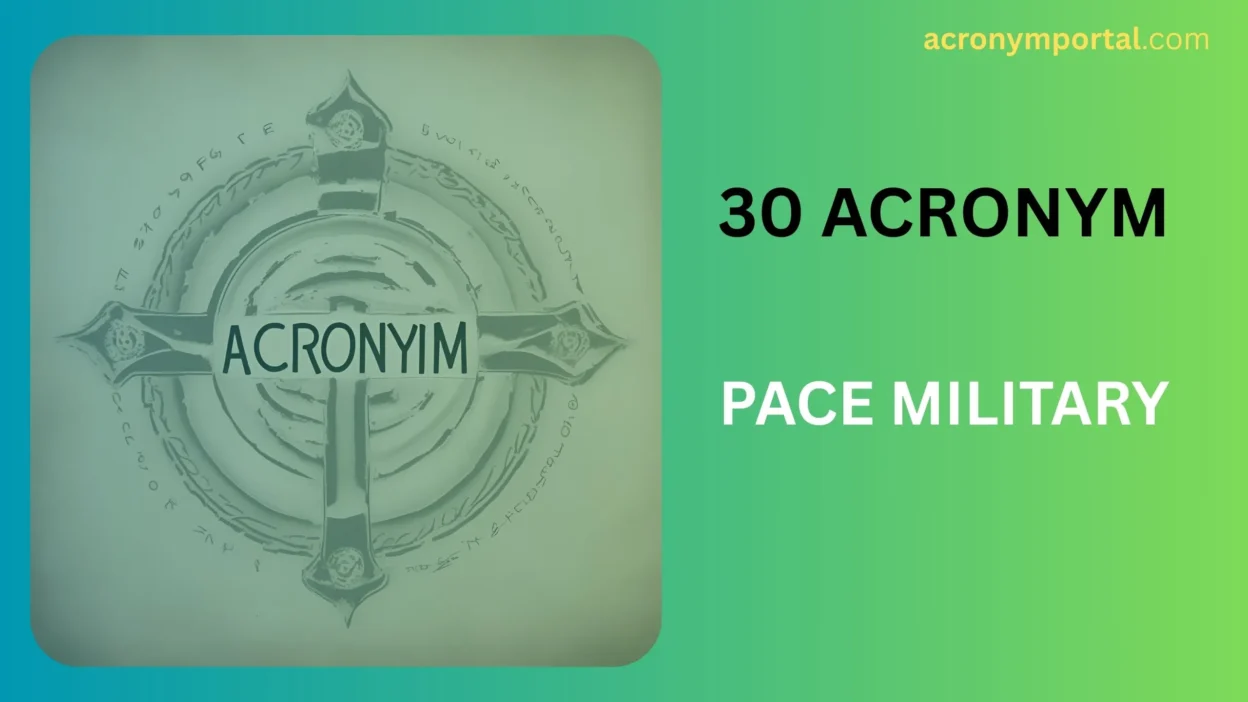In military operations, clarity and structure are critical—and that’s where acronyms like PACE come in. The PACE military acronym stands for Primary, Alternate, Contingency, Emergency. It’s a communication planning framework designed to ensure uninterrupted contact, even under rapidly changing conditions.
But beyond its tactical utility, PACE has inspired broader usage across sectors—project management, emergency services, tech, and leadership training—where reliable communication is non-negotiable.
In this article, we’ll break down the PACE framework, then introduce 30 alternative acronyms or acronym-based strategies that relate to or support the PACE mindset. For each, we’ll provide a short explanation, practical usage example, and guidance on when to use it based on tone, urgency, and context.
🧠 What Is the PACE Military Acronym?
PACE stands for:
- Primary – Your main method of communication (e.g., radio)
- Alternate – A backup if the primary fails (e.g., mobile phone)
- Contingency – A fallback if both above fail (e.g., messenger)
- Emergency – The final-resort method, possibly high-risk or basic (e.g., flares)
The key principle? Redundancy builds resilience. Whether in war zones or corporate war rooms, having layered communication plans helps teams maintain control, adapt fast, and avoid failure.
🔄 30 Acronym-Based Alternatives and Support Systems
Here are 30 frameworks, acronyms, or models that align with or complement the PACE strategy—ideal for military, emergency services, security teams, or strategic planners.
1. OODA – Observe, Orient, Decide, Act
Use: Decision-making under pressure.
Example: Pilots use the OODA loop to react quickly during air combat.
Best for: Fast-paced tactical environments.
2. TLP – Troop Leading Procedures
Use: Operational planning for small unit leaders.
Example: He followed TLP to brief the squad before movement.
Best for: Squad-level leadership in military operations.
3. MDMP – Military Decision-Making Process
Use: Structured planning at battalion level and above.
Example: The staff used MDMP to develop mission options.
Best for: Large-scale, formal military operations.
4. SMEAC – Situation, Mission, Execution, Admin/Logistics, Command/Signal
Use: Briefing format.
Example: The commander gave a clear SMEAC before the mission.
Best for: Field briefings and mission communication.
5. METT-TC – Mission, Enemy, Terrain, Troops, Time, Civilians
Use: Operational analysis.
Example: We assessed METT-TC before the recon.
Best for: Pre-mission planning in the field.
6. 5Ws – Who, What, When, Where, Why
Use: Basic intel gathering or report writing.
Example: Intel reports followed the 5Ws format.
Best for: Simplified situational clarity.
7. SALT – Size, Activity, Location, Time
Use: Spot reports or tactical observations.
Example: He radioed in a SALT report after contact.
Best for: Recon and short-field communications.
8. ACE – Assess, Communicate, Execute
Use: Crisis leadership or quick-response situations.
Example: In critical failure mode, we followed the ACE model.
Best for: Crisis management and leadership.
9. COA – Course of Action
Use: Strategic options during planning.
Example: We reviewed three COAs before choosing the best.
Best for: Operational flexibility.
10. FEMA’s ICS – Incident Command System
Use: Civil emergency coordination.
Example: FEMA deployed ICS protocols after the hurricane.
Best for: Inter-agency disaster response.
11. C3 – Command, Control, Communications
Use: Core military leadership framework.
Example: Strong C3 systems ensure mission success.
Best for: Centralized coordination.
12. C4ISR – Command, Control, Communications, Computers, Intelligence, Surveillance, Reconnaissance
Use: Modern battle command systems.
Example: C4ISR tech allows real-time intelligence.
Best for: High-tech military and surveillance ops.
13. RACE – Recognize, Assess, Communicate, Execute
Use: Emergency management model.
Example: Use RACE to respond to chemical incidents.
Best for: Hazmat and incident response.
14. ATTP – Army Tactics, Techniques, and Procedures
Use: Field manuals and guides.
Example: The unit trained according to the latest ATTP.
Best for: Military doctrine and standardization.
15. REDCON – Readiness Condition
Use: Level of combat readiness.
Example: The platoon was at REDCON-1 before the assault.
Best for: Combat alert status.
16. MARCH – Massive Hemorrhage, Airway, Respiration, Circulation, Head Injury
Use: Tactical combat casualty care.
Example: He used MARCH to stabilize the wounded soldier.
Best for: Military medical response.
17. PIR – Priority Intelligence Requirements
Use: Intel targeting during missions.
Example: Command set PIR to locate enemy artillery.
Best for: Intelligence operations.
18. SOP – Standard Operating Procedure
Use: Preset procedure for operations.
Example: Follow the SOP during blackout drills.
Best for: Repetitive mission tasks.
19. OCOKA – Observation, Cover/Concealment, Obstacles, Key Terrain, Avenues of Approach
Use: Terrain analysis.
Example: Use OCOKA when planning defensive positions.
Best for: Combat engineers and tacticians.
20. TTLODAC – Task, Target, Location, Observer, Delivery System, Attack Guidance, Communication
Use: Fire support coordination.
Example: TTLODAC ensures fire support accuracy.
Best for: Artillery or air-ground coordination.
21. SAFECOM – Safety Communication Report
Use: Reporting unsafe actions or incidents.
Example: Submit a SAFECOM after near-miss events.
Best for: Aviation and safety reporting.
22. POWDER – Personal, Objective, Weather, Distance, Equipment, Route
Use: Recon preparation.
Example: Run POWDER before any dismounted patrol.
Best for: Individual mission readiness.
23. BLUF – Bottom Line Up Front
Use: Clear, efficient communication.
Example: Military memos should use BLUF for clarity.
Best for: Briefings and reports.
24. IPP – Initial Planning Process
Use: Kicks off mission planning.
Example: IPP began as soon as the mission dropped.
Best for: Rapid team planning.
25. MIST – Mechanism, Injuries, Symptoms, Treatment
Use: Casualty evacuation reports.
Example: Medics use MIST when handing off patients.
Best for: Field medical coordination.
26. CCIR – Commander’s Critical Information Requirements
Use: Info needed to make key decisions.
Example: Intel failed to meet the CCIR threshold.
Best for: Real-time decision-making.
27. PEACE – Planning, Execution, Assessment, Communication, Evaluation
Use: Peacekeeping or conflict de-escalation ops.
Example: The unit adopted PEACE to rebuild trust post-conflict.
Best for: Humanitarian/multinational missions.
28. SITREP – Situation Report
Use: Field updates.
Example: A SITREP was sent every two hours.
Best for: All operations, military or civilian.
29. SOPREP – Special Operations Personnel Recovery Report
Use: Specialized personnel recovery tracking.
Example: He filled out a SOPREP before deployment.
Best for: SOF (Special Operations Forces).
30. PACE+ – Primary, Alternate, Contingency, Emergency + Training
Use: Modernized PACE with added readiness focus.
Example: PACE+ added rehearsal layers to comms planning.
Best for: Teams prioritizing preparedness and training.
🧭 Choosing the Right Framework
To select the right acronym or strategy:
- Tactical vs Strategic: Use PACE, OODA, or MDMP for operational planning. Use SALT or SITREP for frontline updates.
- Medical vs Combat: Choose MARCH or MIST for battlefield medics; COA and TTLODAC for kinetic planning.
- Civil vs Military Use: Frameworks like FEMA ICS, PEACE, or SAFECOM work across sectors.
- Communication Depth: PACE gives structure, while BLUF and SMEAC enhance clarity in messaging.
🎖 Conclusion
The PACE acronym isn’t just a military relic—it’s a modern-day mindset. Whether you’re in a command post, on a project team, or running crisis response, layered communication planning is vital. These 30 alternatives allow you to adapt the PACE philosophy to fit your mission, context, and urgency level.
So next time you’re designing a communication plan or writing a strategy memo, ask yourself:
Do I have a Primary, Alternate, Contingency, and Emergency?
If not—now you know 30 ways to get there.




